Technology and Investment
Vol.4 No.2(2013), Article ID:31876,6 pages DOI:10.4236/ti.2013.42013
Research on User Experience Quality Assessment Model of Smart Mobile Phone*
1School of Business Administration, South China University of Technology, Guangzhou, China
2Institute of Emerging Industrialization Development, South China University of Technology, Guangzhou, China
Email: scutwjp@126.com, zhuyahui0819@qq.com, houjiajun12@sina.com
Copyright © 2013 Jiangping Wan et al. This is an open access article distributed under the Creative Commons Attribution License, which permits unrestricted use, distribution, and reproduction in any medium, provided the original work is properly cited.
Received March 19, 2013; revised April 29, 2013; accepted May 6, 2013
Keywords: User Experience; Smart Mobile Phone; Grounded Theory; Analytic Hierarchy Process; Quality Assessment
ABSTRACT
The user experience influencing factors of smart mobile phone is explored in order to assess its quality. At first, we discover user experience influencing factors of smart mobile phone and establish user experience quality assessment model with grounded theory, which include both environmental experience and user experience, then calculate the weight for each factor with analytic hierarchy process: interaction (0.115), usability (0.283), durability (0.091), innovation (0.104), screen vision (0.098), appearance design (0.071), touch experience (0.057), entertainment(0.133), emotional beggar (0.048), and first four key influencing factors are discovered as follows: usability, entertainment, interaction and innovation. Finally, the model is verified through quality assessment for five smart mobile phones, we hope that it can give some inspiration to mobile phone manufacturers and operators.
1. Introduction
The Harvard Business Review ran an article titled “Welcome to the Experience Economy”. Pine and Gilmore, who wrote a book by the same name, argue that the entire history of economic progress could be captured as a progression from extracting commodities (agrarian economy), to making goods (industrial economy), to delivering services (service economy), and now, to one of staging experiences (experience economy). The article suggests characteristics of desirable experiences that draw heavily from entertainment and customer service, as well as five principles for designing such experiences: theme the experience, fulfill it in all the details, harmonize the impression with positive cues, eliminate negative cues, and mix in memorabilia [1].
Smart mobile phone is developing very rapidly in 2012, subsequently also brought fierce competition, apparently its user experience is very important.
This paper is organized as follows: introduction and literature review are in the first, then research design, discovery user experience influencing factors of smart mobile phone with grounded theory, and establish user experience quality assessment model for smart mobile phone are in the following, quality assessment for five smart mobile phones and conclusions are in the end.
2. Literature Review
Mohammed defined the user experience as the motivators and feedback feeling during the interaction with the product or the website [2]. Jesse J. Garrett thought it is the performance and operation of the product in the real world [3].
With the improvement of user requirement, experience has become “wide spread, wide angle” [4], evolves into a kind of complete experience which formed during the process of users interacting with the mobile phone. The simple way to think about what influences experience is to think about the components of a user-product interaction, and what surrounds it [5] and procedures needed by persons who are about to embark on their first qualitative research projects and who want to obtain the conclusion.
Ground theory to provide the basic knowledge and procedures needed by persons who are about to embark on their first qualitative research projects and who want to build theory at the substantive level [6]. The main steps of grounded theory are as follows: 1) Theoretical sampling. 2) Collecting information. 3) Coding information, and forming the concepts from information. 4) Continually comparing between data, and between conceptions and between data and conceptions. 5) Forming theoretical conceptions, and establishing the relationships between conceptions. 6) Building theory and judging it. J. P. Wan and H. Zhang once studied on influencing factors of Web 3D user experience with grounded theory and analytic hierarchy process (AHP), and discovered four influencing factors: website quality, external environmental factors, user internal factors and recommendation, and the influencing factor model of Web 3D user experience was tried to established [7].
3. Research Design
Research framework is illustrated in Figure 1. At first, we discover user experience (UX) influencing factors of smart mobile phone with grounded theory, and establish user experience quality assessment model for smart mobile phone with AHP and discover the four influencing factors. Finally, there are quality assessment for five smart mobile phone and conclusions.
4. Discover User Experience Influencing Factors of Smart Mobile Phone with Grounded Theory
The idea of the user is understood with questionnaires and interviews, and the user experience’s influencing factors are identified with grounded theory.
The characteristics of the 20 interviewed undergraduates as follow: 1) higher-level education, accept and understand new things quickly; 2) using smart phone more
than two years, familiar with at least five kinds of smart phones; 3) loving and enjoying life.
We discover 12 categories and 60 concepts through theoretical sampling, collecting information, coding information, continually comparing between data and conceptions (Table 1).
The key task of axial coding is to explore and establish a relationship between the categories, rather than build a comprehensive theoretical model. We obtain 2 categories and 4 subcategories with axial coding (Table 2).
The core categories “user experience” were identified through continually comparing between primary sources of information, and between the results of the open coding and between the results of the axial coding (Figure 2).
User experience influencing factors of smart mobile phone were discovered with grounded theory, mainly included the environment experience and user experience. External environment included the signal, network, virus, Economic factors, and other external factors. The three dimensions of user experience were service quality, sensory quality and emotion quality. Service quality included interaction, usability, durability and innovation; Sensory quality included screen vision, appearance design and touch experience; emotion quality included entertainment and emotional beggar.
5. Build User Experience Quality Assessment Model for Smart Mobile Phone
Having discovery user experience influencing factors of smart mobile phone, we obtained the factor model which
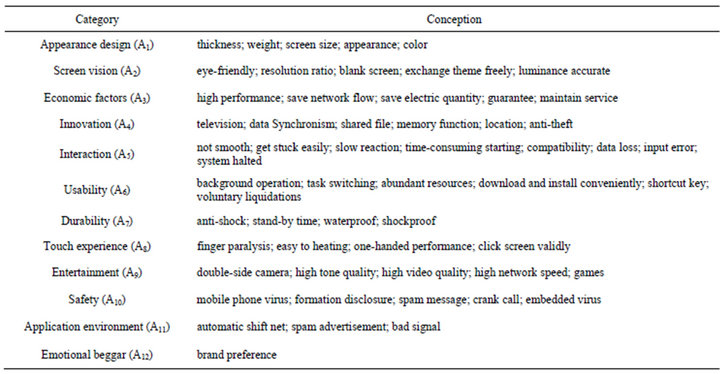
Table 1. The result of the open coding.

Figure 1. Research framework.

Figure 2. User experience influencing factors model.

Table 2. The result of axial coding.
consists of three levels, and transformed the model to be the user experience quality assessment model for smart phone (Table 3).
We can see the ranking of the first-class indicators in Tables 4-6: B1 Service quality, B2 Sensory quality, B3 Emotion quality; the ranking of the second-class indicators is: usability, entertainment, interaction, innovation, screen vision, durability, appearance design, touch experience, emotional beggar.
According to the ranking, we obtained the first four key influencing factors as follows: usability, entertainment, interaction and innovation.

Table 3. User experience quality assessment hierarchy.

Table 4. The judgment matrix of first-class indicator.
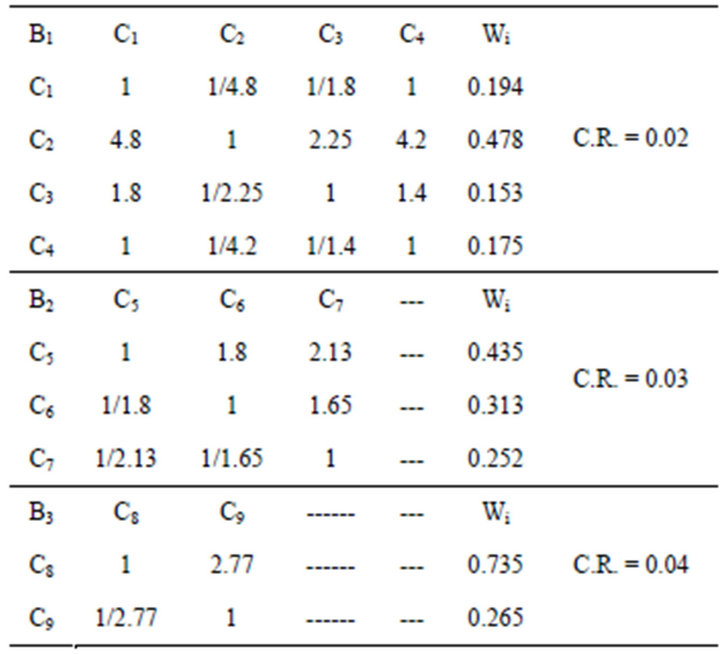
Table 5. The judgment matrix of second-class indicator.
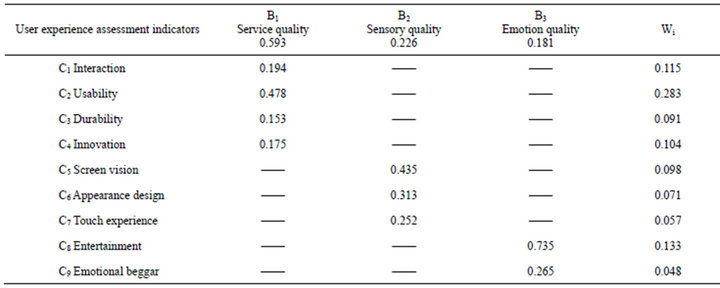
Table 6. The weight of user experience quality assessment dictator.
6. Quality Assessment for Five Smart Mobile Phones
Having analyzed the user experience quality assessment model for smart mobile phone, we chose and analyzed five smart mobile phones to verify the model.
We invited eight experts to give a mark to the different aspects of five mobile phone brands.According to the 1-9 Samsung D1, Apple D2, Blackberry D3, Nokia D4 and HTC D5.
Basing on the IDC ranking data in January 2013 (Table 7), the Smartphone brands we selected were scale meaning table, we use the software Expert Choice to evaluate and comprehensive the result, the final matrix was illustrated in Table 8.
The characteristics of the eight experts were as follows: 1) higher-level education, very familiar with the smart phones and Internet business; 2) using smart phone more than three years, familiar with the five smart phones we selected; 3) loving and enjoying life.
According to the above calculation results, the C.R. values of all the judgment matrices are less than 0.1. Therefore, all judgment matrices pass the consistency check and the results are proved reliable.
First, we calculated the weight for each factor with AHP, the results: interaction (0.115), usability (0.283), durability (0.091), innovation (0.104), screen vision (0.098), appearance design (0.071), touch experience (0.057), entertainment (0.133), emotional beggar (0.048). Second, we calculated the weight of each second-class indicator for each phone brand (Table 9), and then added them to obtain the weight of the user experience of five different phones (Table 10).
Therefore, we use the AHP to get the descending ranking of the five mobile phones: Apple, Samsung, Nokia, HTC and Blackberry. Choosing the values of nine second-class indicators of Apple: interaction (0.402), usability (0.413), durability (0.151), innovation (0.413), screen vision (0.329), appearance design (0.354), touch experience (0.288), entertainment (0.425), emotional beggar (0.452).
In the research of the user experience quality assessment model, we obtained four key influencing indicators: usability, entertainment, interaction and innovation. The values of Apple are as follow: usability (0.413), entertainment (0.425), interaction (0.402) and innovation (0.413). We can see its values are far more than the others, Apple iPhone has a obviously competitive advantage in the user experience.
What makes an iPhone unlike anything else? Maybe it’s that it lets you do so many things. Or that it lets you do so many things so easily. Those are two reasons iPhone owners say they love their iPhone. But there are many others as well.
Every detail and every material has been meticulously considered and refined. As a result, iPhone feels substantial in your hand and perfect in your pocket.
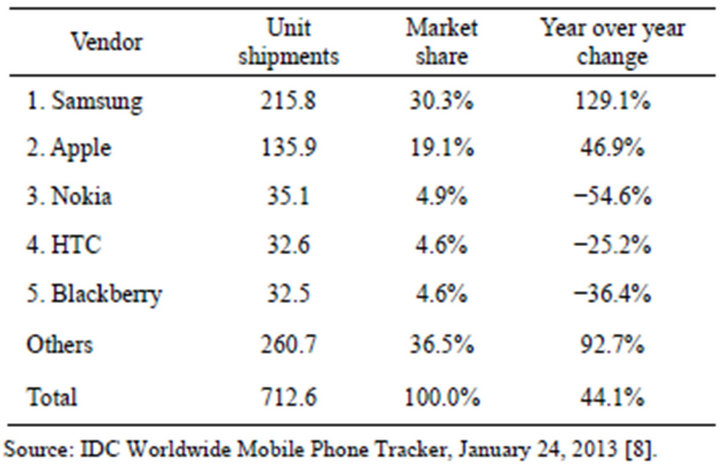
Table 7. Top five smart phone shipments, and market share.

Table 8. The assessment matrix of UX for five smart mobile phone.

Table 9. The analysis result of the dictator of five smart mobile phone.
Millions of ways to be entertained, from one trusted source. The more apps, music, movies, and TV shows you download, the more you realize there’s almost no limit to what iPhone can do. The iTunes Store is the world’s largest and most trusted entertainment store. Other mobile platforms have a myriad of fragmented store options, resulting in availability issues, developer frustration, and security risks.
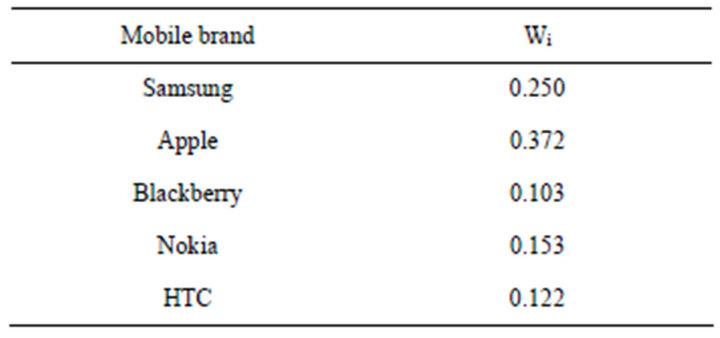
Table 10. the weight of the UX of five smart mobile phones.
iPhone is so easy to use thanks to iOS 6. Innovative features like Siri and FaceTime plus built-in apps make iPhone not just useful but fun. Siri, the intelligent assistant, lets you use your voice to send messages, schedule meetings, place calls, set reminders, and more.
Of course, if other vendors wanted to give users a better experience and get more market share, they should learn how to seize and improve the key influencing indicators, and continuously improve and develop themselves.
7. Conclusion
This article combined and analyzed the Smartphone and user experience, it had a strong practical significance. First, we establish user experience quality assessment model with grounded theory, the first-class indicators are: service quality, sensory quality, emotive quality; the second-class indicators are: usability, entertainment, interaction, innovation, screen vision, durability, appearance design, touch experience, emotional beggar. Second, we applied AHP to research the user experience quality assessment model, and obtained four key influencing indicators: usability, entertainment, interaction and innovation. We also apply AHP to get the descending ranking of the five mobile phones: Apple, Samsung, Nokia, HTC and Blackberry. After analyzing the value of Apple, we can see its values are far more than the others, Apple iPhone has an obvious competitive advantage in the user experience, all of those demonstrated the correctness of the model (In spite of many associated reasons), our results can give inspiration to smart mobile phone manufacturers and operators.
8. Acknowledgements
Thanks for helpful discussion with Mr. Xiao Yan, Mr. Yongchao Zhang, Mr. Shiqiu Liu and Mr. Yun Bai, etc.
REFERENCES
- B. J. Pine, II and J. H. Gilmore, “Welcome to the Experience Economy,” Harvard Business Review, July-August 1998, p. 95-105.
- R. A. Mohammed, “Internet Marketing: Building Advantage in the Networked Economy,” McGraw-Hill Press, Boston, 2002.
- J. J. Garrett, “The Elements of User Experience: UserCentered Design for the Web,” AIGA New Riders Press, New York, 2002.
- E. L. Law, V. Roto, M. Hassenzahl, A. P. Vermeeren and J. Kort, “Understanding, Scoping and Defining User Experience: A Survey Approach,” In: Proceedings of CHI’09, ACM, New York, 2009, pp. 719-728.
- J. Forlizzi and S. Ford, “The Building Blocks of Experience: An Early Framework for Interaction Designers,” In: D. Boyarski and W. A. Kellogg, Eds., Processes, Practices, Methods, and Techniques, Proceedings of the 3rd conference on Designing Interactive Systems, New York, 17-19 August 2000, pp. 419-423..
- J. Corbin and Strauss, “A Basics of Qualitative Research: Techniques and Procedures for Developing Grounded Theory,” Sage, London, 1990.
- J. P. Wan and H. Zhang, “Research on Influencing Factors of Web 3D User Experience with Grounded Theory 9J,” iBusiness, Vol. 3, No. 3, 2011, pp. 237-243.
- “IDC Worldwide Mobile Phone Tracker,” 2013. http://www.idc.com/getdoc.jsp?containerId=prUS239164
NOTES
*This research was supported by Key Project of Guangdong Province Education Office (06JDXM63002), NSF of China (70471091).

